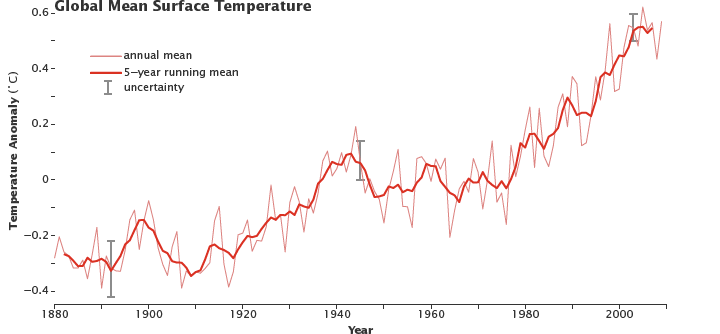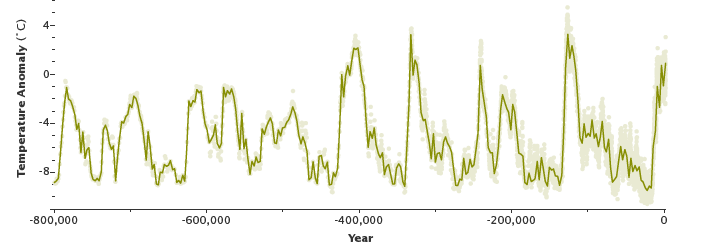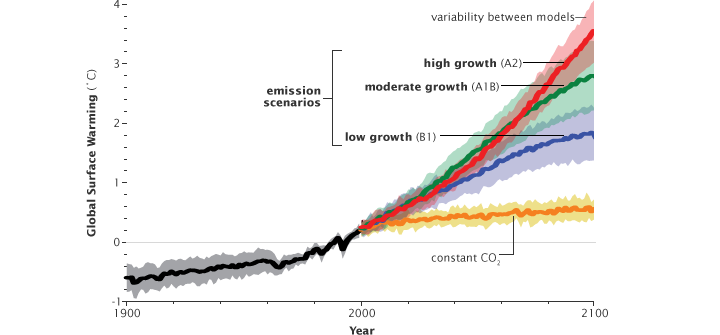Global Warming
Earth has often warmed and cooled throughout the course of its lengthy history. The planet's climate has altered as a result of tiny orbital changes, changes to the atmosphere or surface, and variations in the Sun's radiation. But in the last century, another force—humanity—has begun to affect Earth's climate.
How does current warming compare to earlier climatic shifts on Earth? How can we be convinced that greenhouse gases created by humans are the reason for the warming? When will the Earth's temperature rise? How is Earth going to react? The biggest scientific problem of our time may be figuring out the answers to these questions.
The extremely quick rise in the planet's average surface temperature over the last century is known as global warming, and it is mostly caused by greenhouse gases that are emitted when people burn fossil fuels. Between 1906 and 2005, the average surface temperature of the whole planet increased by 0.6 to 0.9 degrees Celsius (1.1 to 1.6 degrees Fahrenheit), and the pace of temperature growth has nearly quadrupled over the previous 50 years. Undoubtedly, the temperature will rise much more.
The organic greenhouse effect on earth
The Sun sets the initial temperature for Earth. On brilliant surfaces like clouds and ice, around 30% of the incoming sunlight is reflected back into space. The land, oceans, and atmosphere together account for the majority of the remaining 70% of emissions. Our earth receives heat from the sun's absorbed energy.
Thermal infrared radiation, or "heat" energy, is emitted by the rocks, the air, and the oceans as they warm. This energy is transmitted into the atmosphere from the surface and is largely absorbed by water vapor and long-lived greenhouse gases like carbon dioxide and methane.
When small water or greenhouse gas molecules absorb the energy emanating from the Earth's surface, they transform into tiny heaters that, like the bricks in a fireplace, radiate heat even after the fire is extinguished. They radiate in all directions. The energy that radiates back toward Earth heats both the lower atmosphere and the surface, supplementing the warmth provided by direct sunshine.
The natural greenhouse effect, which involves the absorption and radiation of heat by the atmosphere, is advantageous to life on Earth. Without the greenhouse effect, the Earth's average surface temperature would be an extremely frigid -18°C (0°F), rather than the comfortable 15°C (59°F) that it is now.
the increased greenhouse impact.
Scientists are concerned because, during the last 250 years, people have intentionally increased the concentration of greenhouse gases in the atmosphere at an ever-increasing rate, mostly via the use of fossil fuels, but also through the destruction of carbon-absorbing forests. Carbon dioxide levels have climbed almost 38 percent since the beginning of the Industrial Revolution about 1750, while methane levels have increased 148 percent.
Because the atmosphere includes more greenhouse gas molecules today, more of the infrared radiation released by the surface is absorbed by the atmosphere. Because part of the extra energy from a warmer atmosphere reflects back to the surface, the Earth's surface temperature rises. We can make the Earth's atmosphere a more efficient greenhouse by increasing the concentration of greenhouse gases.
How is today's warming distinct from previous ones?
Climate change has occurred in the past without the assistance of humans. We can learn about historical temperatures thanks to evidence left in tree rings, glacial ice layers, ocean sediments, coral reefs, and sedimentary rock strata. Bubbles of air in glacial ice, for example, capture microscopic samples of Earth's atmosphere, providing scientists with a history of greenhouse gases dating back more than 800,000 years. The chemical composition of ice reveals information about the worldwide average temperature.
Using this historical data, scientists have created a record of Earth's previous climates, or "paleoclimates." The paleoclimate record, when integrated with global models, reveals earlier ice ages as well as eras significantly warmer than present. However, the paleoclimate record shows that present climatic warming is substantially faster than previous warming occurrences.
Over the last million years, when the Earth emerged from ice periods, the global temperature soared by 4 to 7 degrees Celsius. The temperature has risen 0.7 degrees Celsius in the last century alone, approximately 10 times faster than the typical pace of ice-age recovery warming.
Models estimate that the Earth will warm by 2 to 6 degrees Celsius during the next century. When global warming has occurred during the last two million years, it has taken the globe around 5,000 years to warm by 5 degrees. The expected pace of warming over the next century is at least 20 times quicker. This pace of change is exceedingly exceptional.Is Current Warming Natural?
Prior to the Industrial Revolution, Earth's climate altered owing to natural factors unrelated to human activities. Most commonly, fluctuations in sunshine have caused global climate to alter. Tiny wobbles in Earth's orbit changed when and where sunlight fell on the planet's surface. Variations in the Sun have alternately boosted and lowered the quantity of solar radiation reaching Earth. Volcanic eruptions have produced particles that reflect sunlight, illuminating the earth and cooling the environment. Volcanic activity has also boosted greenhouse gases over millions of years, leading to episodes of global warming.
Though humans have had the greatest effect on our climate since 1950, natural changes to the Earth's climate have also happened recently. For example, two significant volcanic eruptions, El Chichon in 1982 and Pinatubo in 1991, sent large amounts of sulfur dioxide gas into the atmosphere. The gas was transformed into small particles that persisted for more than a year, reflecting sunlight and darkening the Earth's surface. Temperatures throughout the world dropped for two to three years.
How Much Warmer Will the Earth Get?
Climate models—computer simulations of the climate system—are being developed by scientists to better investigate the causes and impacts of global warming and to forecast future warming. Climate models are intended to replicate the responses and interactions of the seas and atmosphere, as well as to account for natural and anthropogenic changes to the land surface. They follow fundamental physics rules of conservation of energy, mass, and momentum and account for hundreds of factors that impact Earth's climate.
Though the models are complex, thorough tests using real-world data refine them into strong tools that allow scientists to explore our understanding of climate in ways that would not be feasible otherwise.Scientists use the models to better understand Earth's current climate and anticipate future climate by experimenting with them—removing greenhouse gases created by the combustion of fossil fuels or adjusting the intensity of the Sun to see how each effects the climate.
The models anticipate that as the globe consumes more fossil fuels, greenhouse gas concentrations will grow, as will the Earth's average surface temperature. According to a variety of feasible emission scenarios, average surface temperatures might rise by 2°C to 6°C by the end of the twenty-first century.
JOIN US ON:
INSTAGRAM @humaansthoughts
TWITTER @humaansthoughts










Comments
Post a Comment